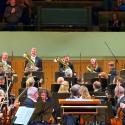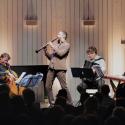If audience reaction is anything to go by, Kahchun Wong’s season-opening first concert officially in post as principal conductor of the Hallé was an outstanding success.
And the reception was deserved. Still young enough, with a mop of hair cascading over his forehead, to look like a Wunderkind, he has considerable experience behind him, with a career on both sides of the world – in south-east Asia and in Europe and America.
That particular characteristic was symbolized in this programme. He has an interest in Britten’s music, and already he and the Hallé have recorded the complete score of The Prince of the Pagodas (its composer’s only full-length ballet score, written for Covent Garden and John Cranko in the mid-1950s). Its rhythmic, colourful music marked a journey by Britten into the soundworld of Balinese gamelan, and there should be sales potential in the East (where Wong, himself from Singapore, is already chief conductor of the Japan Philharmonic).
For this concert he and Colin Matthews, the Hallé’s composer emeritus, devised a 30-minute suite from the ballet, and it was followed by Mahler’s Symphony no. 1, for which, as a past winner of the Gustav Mahler Conducting Competition and student of Kurt Masur, Kahchun Wong can also claim to a powerful and authentic voice.
The Prince of the Pagodas suite, about 30 minutes in total, is really a sequence of excerpts, in the order in which they come in the story – as Kahchun Wong mentioned in a pre-concert audience talk, he can conduct it from the complete score, simply using clips to move from one item in the suite to the next (he also mentioned that in rehearsal the plan was trimmed a little, omitting a few bits they’d thought to include, such as the Pas de trois from Act 3).
With the Bridgewater Hall platform extended to accommodate the full orchestra and army of percussion Britten used – it’s been called his “concerto for orchestra”, as the only extended piece he wrote for such lavish resources – the suite serves extremely well as a showpiece for the Hallé’s musicians. Stéphane Rancourt’s oboe solo in the music for Belle Rose’s arrival and adventures in the kingdom of the pagodas was ravishingly beautiful and delicate, and preceded by a watery clarinet duet (Sergio Castelló López and Dan Bailey) from the music for sea horses, fish creatures and waves. The percussionists acquitted themselves with superb skill in the imitation gamelan effects from Act 3, and the conclusion, with its jolly waltz introduced by Laurence Rogers and his horn colleagues, came to a thoroughly exciting big finish.
Mahler’s First Symphony, which Kahchun Wong conducted from memory, was a seriously impressive achievement. The Hallé have played it plenty of times before, of course, including under Sir Mark Elder in 2007, but this one caught its spirit perhaps more completely than ever.
There’s a range of sonic effect from tiny, whispered string harmonics to roof-raising brassy power in it, and the performance projected every degree of that in outstanding clarity. Not just effects, too: the sense of atmosphere and building of suspense and tension, the sweetness and delicacy of the string playing at many points, and trumpet interjections like flashes of lightning, all played their part in creating a musical journey. There was enough flexibility in the phrasing to bring each element of the tableau to life, while the tempo changes were clearly marked and the climaxes unmistakable … and that was just the first movement.
For the second, Wong wanted emphasis and vigour, his arms swinging at full stretch, all the texture in full focus – and it was fun as well. The Trio section was both insinuating and saucily beautiful. The klezmer music of the third swung along with big tempo variances, contrasting with the folksong music, gently and affectionately offered and seeming almost to be lost in its own innocence.
The finale began with the same fury as the first movement had ended, but continued ever responsive to Mahler’s calls for playing to be “song-ful” and “sung”, not just marching onward. The “stormy” music was almost desperately so, and the perorations, duly thunderous, brought a sense of triumph that was palpable. It was a declaration of thrilling things to come.















Add comment